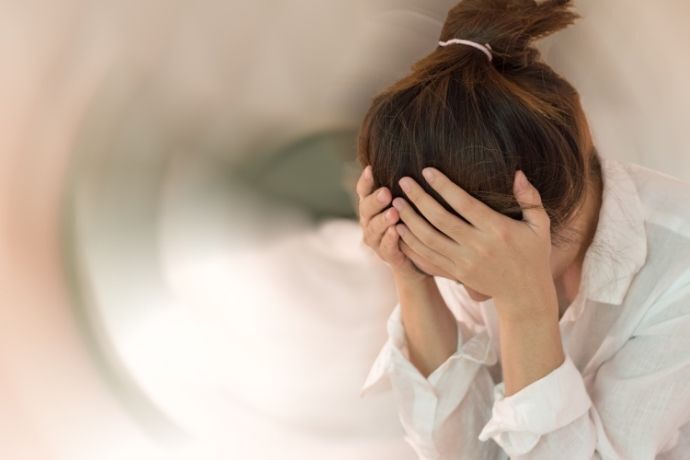Table of contents
Learn more about the types of headache and their treatments!

In this article, we will learn more about a problem that afflicts many people: headache. Everyone has experienced headache, and the causes are numerous. There are people who suffer from constant headaches, which deprives them of a better quality of life.
Headache is classified into several types, there are about 150 of them. First, headaches are divided into primary and secondary pains, and each of these groups has subdivisions that specify degrees, symptoms and causes. They can even occur in different regions of the head.
There is also a difference between tension headache, caused by tension in the muscles, and migraine, a persistent pain that can have a variety of causes. Follow below for detailed and useful information about headache.
Understanding more about headache

We will understand more about headache, knowing what it is, its symptoms, what are the dangers of frequent headache and how it is diagnosed and evaluated. Check it out.
What is the headache?
Headache is a symptom, that is, a sign that alerts to some cause or origin. It can happen in any region of the head, and in some cases occur by irradiation, when the pain spreads from one point. Headache can appear gradually or immediately, and can have various degrees of intensity and different times of duration.
Among Brazilians, it appears in fifth place among the most frequent health problems, after anxiety, stress, respiratory allergy and back pain. Stress, lack of sleep, incorrect posture, muscle tension and even diet can be causes for this frequent discomfort.
Symptoms of headache
Tension headaches, the most common type, tend to be consistent, can occur on both sides of the head and worsen with physical exertion, while migraines have moderate to severe throbbing pain, nausea or vomiting may occur, as well as sensitivity to light, noise or odors.
Cluster headaches are more severe and rare and can last for long periods. The pain is intense and manifests itself only on one side of the head, accompanied by nasal discharge and red and watery eyes.
Sinus headaches are symptoms of sinusitis, caused by congestion and inflammation of the sinuses.
Dangers and care of frequent headache
Frequent headaches, even those that are not severe but persistent, need to be investigated, so be sure to see a doctor if you have headache and headache-related symptoms.
Pay attention if the headache starts suddenly and with great intensity. If it does not go away even with the help of painkillers, seek medical assistance.
Adjacent symptoms such as mental confusion, high fever, fainting, motor changes, and neck stiffness are signs that this is not a normal headache and may be symptoms of serious illnesses such as meningitis, stroke, and aneurysm.
How are headaches assessed and diagnosed?
When investigating the headache, the first thing to be evaluated is the intensity and duration of the pain. In addition, relevant information will be required by the doctor, such as when it started and if there is any identifiable cause (excessive physical exertion, recent trauma, use of certain medications, among other possible reasons).
The definition of the pain as primary or secondary will guide the type of treatment. Physical examination and medical history are part of the further evaluation. For some types of headache, diagnostic tests are performed to determine the cause, such as blood tests, MRI or CT scan.
Types of headache - Primary headaches

In order to delve deeper into headache, it is necessary to address the types of headache. We will know below the headaches that are known as primary headaches.
Tension headache
Tension headache is classified as primary headache and is the most common type of headache. The pain can be mild, moderate or severe, and usually appears behind the eyes, in the head and neck. It is common for patients with tension headache to describe it as the feeling of having a tight band around the forehead.
This is a type of headache experienced by the great majority of the population in an episodic way, which can occur every month. There are rare cases of chronic tension headache, which is characterized by long lasting episodes (more than fifteen days per month). Women are twice as likely as men to suffer from this type of tension headache.
Tension headaches are caused by muscle contractions in the head and neck regions. The tension is due to several factors and habits, such as activities that overload, diet, stress, too much time in front of the computer, dehydration, exposure to low temperatures, excess caffeine, smoking and alcohol, bad nights' sleep, among other stressors.
Generally, just changing habits is enough to relieve tension headache. For persistent cases, there are treatment options, from medications such as painkillers and muscle relaxants to acupuncture and other therapies.
Salve headache
The symptoms that characterize cluster headache are intense and penetrating pain. This pain is felt in the eye region, especially behind the eye, occurring on one side of the face at a time. The affected side may present lacrimation, redness and swelling, besides nasal congestion. The episodes occur in series, that is, crises lasting from 15 minutes to 3 hours.
It is common for those who experience cluster headache to suffer with daily repeats at intervals, possibly at the same time every day, which causes considerable distress as attacks can extend over months. In this way, patients who have cluster headache go months without feeling anything and months with symptoms occurring daily.
Cluster headache is three times more common in men than in women, but its causes have not yet been precisely determined. There are more severe cases in which the patient develops a chronic version of this type of headache, in which the symptoms occur regularly for more than a year, followed by a headache-free period lasting less than a month.
Diagnosis depends on physical and neurological examination and treatment is done with medication. When these do not work, surgery may be required.
Migraine
Migraine is characterized as a pulsation in the back of the head. This pain is intense and is usually unilateral, that is, concentrated on one side of the head. It can last for days, which significantly limits the patient in relation to his daily tasks. In addition to the pain, the patient is sensitive to light and noise.
Other adjacent symptoms are nausea and vomiting, as well as tingling on one side of the face or arm, and, in intense degrees, difficulty speaking. One sign that migraine is occurring is the perception of various visual disturbances: flashing or flickering lights, zigzagging lines, stars, and blind spots.
These disorders are called migraine auras and precede headache in one-third of people. Be aware that migraine symptoms can be very similar to those of a stroke. When in doubt, seek immediate medical attention.
Women are more likely than men to suffer from this type of headache. As for the causes of migraine, they range from genetic occurrence to anxiety, hormonal changes, substance abuse and association with other nervous system conditions. Treatment is done with medication and relaxation techniques.
Continuous hemicrania
Continuous Hemicrania is a primary headache, that is, it is part of the category of headaches that do not necessarily originate due to other diseases, since secondary headaches correspond to symptoms of certain medical conditions.
It is characterized as a headache of moderate intensity, which occurs unilaterally, that is, on one side of the head, with continuous duration that can last for several months. Throughout the day, its intensity is variable, with mild pain in some hours and intensifying at certain times.
Within the types of headaches, continuous Hemicrania accounts for about 1%, which means that it is not the type of headache with the highest incidence in the population. Continuous Hemicrania is twice as common in women.
Some adjacent symptoms may appear in episodes of continuous hemicrania, such as tearing or redness of the eyes, runny nose, nasal congestion and sweating in the head. A part of the patients may demonstrate restlessness or agitation, besides presenting eyelid drooping and temporary miosis (pupil contraction).
The causes of HC have not yet been determined and treatment is given with a medication called indomethacin, a nonsteroidal anti-inflammatory drug (NSAID). Other medication options include other NSAID alternatives or the antidepressant amitriptyline.
Ice pick headache
Ice pick headache is also referred to as short duration headache syndrome. It can be classified as primary pain, when it is not caused by another associated diagnosis, or as secondary pain, when it originates from a pre-existing condition.
It is characterized by intense, sudden and short pains, lasting only a few seconds, which can occur throughout the day. A distinctive aspect of its symptoms is that this type of pain tends to move to different regions of the head. In addition, it is quite common for this headache to arise during sleep or waking hours.
Among its symptoms, the most striking are: the short duration of pain that, although intense, lasts a few seconds and the occurrence in waves, that is, the return of pain over several hours with intervals, which can happen 50 times a day. The most frequent location of pain is on the top, front or sides of the head.
The cause of this type of headache is currently unknown, but it is believed to be associated with short-term disruptions in the brain's central pain control mechanisms. Treatment is preventative and includes medications such as indomethacin, gabapentin, and melatonin.
Thunderstorm headache
The nature of thunderstorm headache is sudden and explosive. It is considered an extremely severe pain that comes on suddenly and progresses to a peak in intensity in less than a minute. This pain may be transient and not due to any underlying condition, but it may be a symptom of a serious problem that requires immediate medical attention.
Therefore, if you experience this type of headache, seek care as soon as possible in order for a doctor to evaluate the possible causes. Symptoms of a thunderstorm headache include sudden and severe pain, and the person experiencing this pain describes it as the worst headache they have ever experienced. The pain may also extend into the neck region and tends to subside after about an hour.
The patient may experience vomiting and nausea and even fainting. The health conditions that can most commonly cause thunderstorm headache are Reversible Cerebral Vasoconstriction Syndrome (RVCS - also known as Call-Fleming Syndrome) and Subarachnoid Hemorrhage (SAH). Less common causes include Cerebral Venous Thrombosis (CVT), arterial dissection, meningitis and, morerarely, stroke.
Other types of headache - Secondary headaches

Secondary headaches are caused by some conditions or disorders. Let's know the most common causes for this type of pain. Follow below.
Headache caused by sinusitis or allergy
Some headaches are caused by sinusitis or allergies. Sinusitis is an inflammation of the tissue that lines the sinuses (hollow spaces behind the cheekbones, forehead and nose). This is the area of the face that produces the mucus that keeps the inside of the nose moist, protecting it from dust, allergens and pollutants.
Sinus infection causes headache and pressure in the sinuses. This pain can be mild to intense and tends to occur more often in the morning. When intense, it can irradiate to the ears and upper jaw. Other symptoms of sinusitis are: runny nose, nasal congestion, yellow, green or white nasal discharge, cough, fatigue and even fever.
The causes of sinusitis are viral infections and allergies that affect the upper respiratory tract. The diagnosis of headache caused by sinusitis or allergy depends on the doctor's evaluation of your health history. Some cases require tests such as CT scan and nasal endoscopy.
Treatment is done with medications to clear the nasal canal as well as to fight infection. Surgery may be an option when medications cannot effectively treat the disease.
Hormonal headache
In women, fluctuating hormone levels can lead to chronic headaches and menstrual migraines. Changes in hormone levels occur during certain cycles, such as menstruation, pregnancy, and menopause, but can also be caused by the use of oral contraceptives as well as hormone replacement.
It is common for women to get rid of hormonal-type headache, or menstrual migraines after the end of the reproductive phase, that is, with the menopause. Scientific research associates the cause of this type of headache to the female hormone estrogen. In women, this hormone controls the chemicals in the brain that affect the sensation of pain.
When a drop in estrogen levels happens, a headache can be triggered. However, hormone levels are affected for numerous reasons beyond the menstrual cycle. In pregnancy, for example, estrogen levels increase, which causes many women to have a break in those Headache attacks.
Even genetic reasons contribute to hormonal migraines, but habits like skipping meals, sleeping and eating poorly, such as drinking too much coffee can also cause them. In addition, stress, weather changes are also factors that trigger flares.
Headache caused by excess caffeine
Abuse of stimulants such as caffeine can also be a cause of headaches. This is because the blood flow to the brain is affected by caffeine consumption. What not everyone knows is that it's not just overeating that causes headaches: stopping drinking coffee can also have the same effect.
In some cases, however, caffeine can relieve headaches, especially in cases of tension headache and migraine, and even potentiate the effect of some painkillers, such as ibuprofen (Advil) or acetaminophen (Tylenol).
Regarding caffeine as a cause of headache, it is estimated that it can trigger headache when ingested in excess because, besides chemically affecting the brain, caffeine has a diuretic action, that is, it can make the person urinate more, causing dehydration.
Caffeine, when consumed in large quantities, can even cause an overdose. In these cases, the side effects do not stop at the headache, and they range from rapid or irregular pulse, to lethargy, vomiting and diarrhea, and can lead to death in extreme cases.
Anvisa (National Health Surveillance Agency) considers as safe the consumption of up to 400 mg of caffeine per day (for healthy people).
Headache caused by overexertion
Intense physical activities cause increased blood flow to the skull, resulting in a pain that is characterized as throbbing and occurs on both sides of the head. These headaches are usually of short duration, disappearing in a few minutes or hours with rest after the effort to which the body was subjected.
Headaches caused by physical exertion are divided into two categories: primary exertional headache and secondary exertional headache. The primary type is harmless and happens exclusively due to physical activity.
The secondary type, on the other hand, causes a pre-existing condition, such as tumors or coronary artery disease, to cause headache during physical exertion. The most striking symptom of an exertional headache is the fact that this pain is throbbing, and it can be located on only one side of the head, but can also be felt throughout the skull.
It can be a moderate to intense pain and can start during or after physical activity that requires effort. When of the primary type, its duration is estimated as variable, i.e., it can last from five minutes to two days. In cases of the secondary type, the pain can last several days.
Headache caused by hypertension
The condition called hypertension, or high blood pressure, manifests itself through alteration in the force of pumping blood through the arteries. In hypertension, the stress exerted by the blood on the vessel walls is consistently too high, causing the walls to expand beyond the normal limit.
This pressure causes tissue damage and increases, the risk of heart attack, stroke and kidney disease. It is common, however, for hypertension not to cause any symptoms, but in rarer cases, severe hypertension may be accompanied by symptoms such as headaches, dizziness, facial flushing and vomiting.
Headaches caused by hypertension usually occur when the pressure gets too high and are usually the result of some underlying health condition of the patient, such as adrenal tumors, hypertensive encephalopathy, pre-eclampsia and eclampsia, or related to drug use or withdrawal.
Withdrawal from beta-blockers, alpha-stimulants (e.g., clonidine) or alcohol can cause elevation of pressure with accompanying headaches. Thus, the patient who knows he has hypertension and has headaches should consult a physician in order to investigate the existence of other health conditions. Following the appropriate treatment prescribed for hypertensive patients is essential, and itincludes maintaining good health habits.
Rebound headache
Rebound headache is caused by the excessive use of medication, especially over-the-counter (OTC) painkillers such as paracetamol, ibuprofen, naproxen, and aspirin, i.e., it is a side effect of the abuse of these substances. These are pains that resemble tension-type headaches, but can also occur in a more intense way, as in migraine headaches.
The use of medications (especially caffeine-containing painkillers) for more than 15 days a month can lead to rebound headache. People who suffer chronically from a specific headache can have episodes of rebound headache when constantly using painkillers.
The symptoms of this type of headache are variable, that is, different symptoms can be triggered depending on the medicine used. These pains tend to occur almost every day, and are quite frequent in the morning. It is common that the person feels relief when taking the painkiller medicine and realizes that the pain returns as soon as the effect of the medicine is over.
Symptoms that are an alarm to seek medical help: nausea, restlessness, memory problems, irritability and difficulty concentrating. People who need to take painkillers more than twice a week should see a doctor to investigate the causes of the headache.
Post-traumatic headache
A concussion is a traumatic brain injury caused by a blow, collision, or blow to the head. This is the most common and least serious type of traumatic brain injury, occurring with high incidence in young people who practice sports and recreational activities, but with causes also related to car and work accidents, falls, and physical assaults.
The impact of a blow or blow to the head can jolt the brain, causing it to move around inside the skull. Concussions can cause bruising, nerve and blood vessel damage. As a result, those who have suffered a concussion may have altered vision and balance, and even become unconscious.
Having a headache immediately following a concussion is normal, but having it within 7 days of the injury is a sign of Post Traumatic Headache. Symptoms resemble Migraine, moderate to severe in intensity. The pain is usually throbbing, and additional symptoms are nausea, vomiting, dizziness, insomnia, memory and concentration problems, mood swings, and sensitivity to light and noise.
A concussion should always be evaluated by a doctor, who may order a CT scan or MRI to rule out bleeding or other serious brain injury.
Cervicogenic (from the spine) headache
Cervicogenic headache is a secondary headache, i.e., caused by another health problem. It results from a disorder in the cervical spine and is characterized as a pain that develops in the neck and back of the neck. The patient reports a pain felt more intensely in the skull region due to irradiation.
It happens frequently on only one side of the head. This type of headache is very common, affecting millions of people. Its occurrence tends to be incapacitating, depending on the intensity of the pain, affecting the routine activities and the quality of life as a whole.
The alterations in the spine that trigger cervicogenic headache are those that affect the cervical vertebrae, such as herniated discs, pinching of cervical roots, stenosis of the cervical canal, but also torticollis and contractures.
People who have a problem with poor posture often complain of headaches, which can be confused with migraines and tension headaches, as both can affect the neck and neck region.
Treating cervicogenic headache depends on treating the problem causing the pain. Effective forms of relief are physical therapies, such as regular exercise and physical therapy, but there are cases that require surgery.
Temporomandibular dysfunction - TMD
Temporomandibular dysfunction (TMD) encompasses a series of clinical problems that affect the masticatory muscles, as well as the temporomandibular joint (TMJ) and its associated structures. This is a syndrome that results in pain and sensitivity in the masticatory muscles, joint sounds caused by opening the jaw, as well as limited mandibular movement.
People suffering from temporomandibular joint pain are one in ten, according to medical research, which has also confirmed a referral of pain from the head to the temporomandibular joint and vice versa. Headache, in these cases, is described as a pinching pain, and the patient finds relief when they are able to relax.
TMD can also trigger Migraine, occurring with additional symptoms, such as facial and neck pain. There is no exact definition for the cause of TMD, but it is known that some habits bring propensity to the development of this dysfunction, such as: frequent clenching of the teeth, especially at night, spending long periods with the jaw supported on the hand, but also chewing gum and chewingthe nails.
To evaluate a possible case of temporomandibular dysfunction, it is recommended to see a dentist. The evaluation consists of palpation of the joint and muscles, as well as detection of noises. Additional tests are magnetic resonance imaging and tomography.
Further information on types of headache

It's important to know a lot about headaches in order to know when they are worrisome and what you can do to prevent them. Below, we'll answer those questions and give you tips on how to relieve your headache.
When is a headache of concern?
In most cases, headaches are episodic, disappearing in about 48 hours. A headache is worrisome if you experience it for more than 2 days, especially those that increase in intensity.
A person who has very regular headaches, that is, for more than 15 days a month over a period of 3 months may have a condition of chronic headache. Some headaches are symptoms of other diseases.
Seek immediate medical attention if you have sudden and severe headache, especially if accompanied by fever, confusion, torticollis, double vision, and difficulty speaking.
What to do to prevent headache?
There are preventive measures that can be helpful in avoiding many types of headaches. Salve headaches, for example, can be prevented by using a drug called Emgality, which eliminates CGRP, a substance that triggers migraine attacks.
In general, changes in habits are the most effective preventive measures to avoid headaches, especially when they are not caused by other diseases.
Positive habits that have the potential to keep the onset of pain away are: sleeping well and at regular hours, adhering to a healthy and balanced diet, staying hydrated, exercising and seeking ways to control stress.
How to relieve the headache?
There are several ways to relieve headache. The most common form of relief for headache is the use of pain medication. First of all, however, it is necessary to identify what type of headache the patient should treat, as there are specific treatments for different types of headaches.
They range from simple dietary adjustments to more invasive procedures that are performed by a doctor when the response to medications, for example, is low. Some headaches respond well to some medications, while others can even be triggered by painkilling drugs designed to treat a certain type of headache.
Be aware of the types of headache and see a doctor if necessary!

It is important to know how headaches occur and especially to investigate their causes if they are frequent or accompanied by other symptoms. Knowing what type of headache is being triggered and why is crucial to finding the right treatment.
There are several factors that cause headaches, from stress, excessive stimulants to physical exertion and hormonal changes. There are, even, pains that warn of some more serious health problem.
In order to rule out the relationship of persistent or very strong headaches with diseases, be sure to consult a doctor and avoid self-medication.

